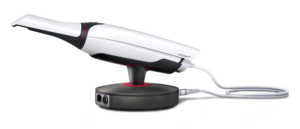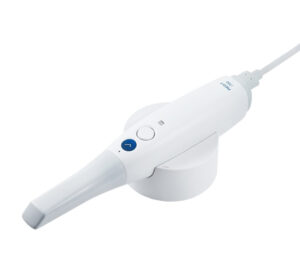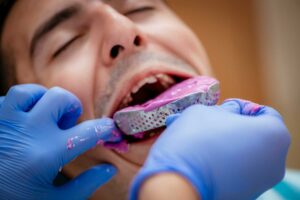As a dentist, if you’re researching intraoral scanners with the intent of choosing one to use in your practice, you’ve come to the right place. Making the move from traditional impressions to digital scans can be quite daunting, especially if it’s your first experience with them. So, we’ve put together this article to help dentists research and choose the best intraoral scanner for their practice and their patients. As always, it’s important to note that although we are expert dental lab technicians and the information we provide is well-researched with the intention to help as best we can, you should always investigate a range of sources when it comes to introducing new technologies to your lab. Let’s dive in, shall we?
How do intraoral scanners work?
In order to answer this question, we should first explain what an intraoral scanner is and what it looks like.
As with most products, intraoral scanner designs vary slightly between types and brands, but essentially, they are compact, handheld camera devices, shaped kind of like a wand with a light source attached. They have the ability to connect to a computer (in a plug-in or wireless capacity, depending on the design) that hosts relevant 3D scanning software.
Think of an intraoral scanner as a digital alternative to traditional impressions – they achieve the same outcome, just in a quicker, more convenient way for the dentist and a more comfortable way for the patient. Rather than using a physical mould, the various details of the oral cavity are captured through high quality images, which can be viewed in real time by dentists on their connected computer screen, and then sent off to a dental lab (like us!) to be transformed into a 3D design using CAD technology.
To use an intraoral scanner, the dentist simply needs to insert the scanning wand into the patient’s mouth and gently move it around, allowing it to capture the size and shape of each tooth, as well as other hard and soft tissues. After a minute or two, the scan will be complete, and the details of the patient’s mouth are held within the computer for easy digital analysis. This instant scan capability allows dentists to create a more efficient process, and, in turn, find the time to treat more patients in their practice.
How do dental labs utilise them?
Technically, it’s not the dental lab that utilises these scanners – it’s the dentists in their own practices. However, dental labs do play their part in the process. As mentioned above, once the scans exist within the 3D scanning software, the data can be easily transferred across to the dentist’s choice of dental lab, allowing for quick and easy communication when it comes to the creation of dental prosthetics like implants, crowns, bridges, dentures, veneers, and more.
So, while we don’t have a need to host an intraoral scanner at Smile Art Lab, we absolutely suggest that our dentists invest in one for their practice. You can find some of our recommended options below.
Types of intraoral scanners
Intraoral scanners are available in a range of different types, but all are created using high-quality technologies to achieve exceptional precision and efficiency in dental imaging. Some of the prominent types used by dentists include:
Confocal microscopy scanners
Utilise a confocal imaging system to capture detailed 3D images by focusing light on a specific point within the oral cavity. They excel in producing high-resolution images with exceptional clarity.
Optical wand scanners
Operate on the principle of structured light or laser technology to project light patterns onto the teeth and gums, capturing precise surface details to create accurate digital models.
Active wavefront sampling scanners
Employ advanced wavefront sampling techniques to ensure comprehensive coverage of the intraoral environment, capturing intricate details with remarkable accuracy and speed.
Infrared radiation scanners
Utilise infrared radiation to penetrate soft tissues, capturing detailed images of the underlying tooth structures and gum contours, facilitating precise digital impressions.
Recommended scanners
There are several intraoral scanners that we recommend as they’ve garnered acclaim for their exceptional performance, reliability, and user-friendly design. Some of the top recommended models are included in the list below.
These scanners all offer easy connection between dental practices and our dental lab for a more streamlined process – but if you choose to use a different type of scanner, we’re definitely still able to accommodate via Dropbox sharing.
3 Shape TRIOS

Renowned for its accuracy and intuitive workflow, the range of 3 Shape TRIOS scanners offers exceptional precision and versatility for a wide range of dental applications.
iTero

Featuring cutting-edge imaging technology and seamless connectivity with CAD and CAM systems, iTero scanners enable precise digital impressions with unmatched ease of use.
Medit

Medit intraoral scanners offer incredible 3D scan solutions to enhance workflow and productivity while ensuring precise results.
Cerec

CEREC offers an intraoral scanner that enables efficient digital workflows from scan to mill in-house or together with your preferred lab (hopefully that’s us).
Carestream

With high-speed scanning capabilities and advanced software integration, Carestream scanners deliver efficiency and reliability for digital dental impressions.
Intraoral scanner resolution
When it comes to utilising imaging technology like this, it’s important to consider resolution. The resolution of intraoral scanners refers to their ability to capture fine details and intricate structures within the oral cavity. Higher resolution scanners offer greater clarity and precision, enabling clinicians and dental technicians to produce prosthetic devices with exceptional accuracy and fit.
Intraoral scanners workflow
As we now know, intraoral scanners function by employing sophisticated optical and imaging technologies to capture detailed 3D images of the oral cavity.
As the scanner is manoeuvred within the mouth, it rapidly captures multiple images from different angles, which are then seamlessly stitched together to generate a comprehensive digital model of the teeth and gums.
This digital impression serves as the foundation for various dental procedures, including the fabrication of crowns, bridges, orthodontic appliances, and implant restorations.
That’s the technical side of things as the scanning is taking place, but what does the full process and workflow look like?
The workflow of intraoral scanners typically involves the following steps:
- Image capture
This is the part of the process mentioned above where the dentist manoeuvres the intraoral scanner within the patient’s mouth, capturing detailed images of the teeth and surrounding tissues from multiple angles.
- Image processing
In just a few minutes, the images are captured and transferred to the connected specialised software where they are processed and stitched together to create a comprehensive digital model of the patient’s oral cavity.
- Design and fabrication
Once the final 3D scan has been processed by the software, the dentist can then utilise the digital model in-house or send it across to their dental lab to design custom restorations, which are then fabricated using advanced CAD technology, milling machines, and 3D printing.
- Clinical evaluation
Once the 3D model of the restoration is crafted, the dentist and their patient can evaluate it for fit, functionality, and aesthetics before being permanently placed in the patient’s mouth.
Of course, intraoral scanner workflows and processes vary between dental practices and dental labs. You can find more information about our simple practice-to-lab communication process at Smile Art Lab by visiting our website or contacting us directly.
What is intraoral imaging used for?
Intraoral imaging has an array of diverse applications across various fields of dentistry, including (but not limited to):
Restorative dentistry
Intraoral scanners are used to create digital impressions for fabricating crowns, bridges, inlays, implant crowns and bridges, veneers, and onlays with precise fit and occlusion. This makes up a big portion of the scans our dentists send to us to work on here at Smile Art Lab.
Orthodontics
Digital models generated by intraoral scanners facilitate the planning and execution of orthodontic treatment, including the design of clear aligners and retainers.
Implant dentistry
Intraoral imaging aids in the precise placement of dental implants by providing detailed anatomical information and facilitating virtual implant planning.
Periodontics
Intraoral scanners assist in the assessment and monitoring of periodontal health, enabling early detection of gingival recession, bone loss, and other periodontal conditions.
Smile Design
At Smile Art Lab, one of the specific services we offer that utilises imaging from intraoral scanners is our Smile Design Service (you can learn more about this via our Smile Design protocol document).
Essentially, this service has been created as a way for us to produce a 3D or 2D preview of a patient’s smile transformation before they move ahead with any restorative procedure. This offers a range of benefits to both the dentist and the patient including:
- The opportunity for the patient to gain confidence in their new smile, making them more likely to move forward with the restoration.
- Allows the patient to have input into their final smile outcomes, before the procedure, leading to happier outcomes and less need for rework.
- Streamlined communication between our lab and the dental practice, improving the flow of the planning stages.
Though we are able to carry our Smile Design service out with traditional scans, we find that it’s a much more streamlined and efficient process when dental practices utilise an intraoral scanner to provide imaging and scans. You’ll see a few of the reasons for this outlined in the section below.
Benefits of intraoral scans compared to traditional impressions.

As you’ve probably come to realise after reading the information above, intraoral scanners can absolutely offer several distinct advantages over traditional impression techniques including:
Improved patient comfort
One of the primary benefits of intraoral scans over traditional scanners is the comfort they provide to patients during the impression capturing process. Unlike traditional impression techniques that involve the use of bulky trays and unpleasant materials like alginate or polyvinyl siloxane (PVS), intraoral scanning eliminates the discomfort associated with these materials. As well as this, patients no longer have to endure the gag reflex induced by traditional impressions, resulting in a more pleasant and positive dental visit overall.
Precision and accuracy
Intraoral scanners offer an incredible level of accuracy when capturing digital impressions of the patient’s dentition. By providing detailed 3D images of the oral cavity, these scans minimise the risk of distortion or inaccuracies commonly associated with traditional impression materials. This precision ensures that the final restoration or prosthesis fits seamlessly, increasing the overall quality of dental care and patient satisfaction.
Efficiency in workflow
In addition to improving patient comfort and accuracy, intraoral scanning significantly streamlines the dental workflow. The digital nature of intraoral scans eliminates the need for physical storage of bulky impression molds, reducing clutter and organisation of dental practices. Moreover, the immediate availability of digital impressions allows for faster communication between dental professionals and dental laboratories, expediting the fabrication process and ultimately reducing the turnaround time for restorations or prosthetics.
Facilitated collaboration
Digital impressions captured by intraoral scanners can be easily shared and manipulated, facilitating seamless communication and collaboration between clinicians and dental laboratories Australia-wide. Dentists can electronically transmit the digital impressions to dental labs like ours, along with specific instructions or preferences for the fabrication of restorations. This real-time communication streamlines the treatment planning process, reduces the likelihood of errors, and ensures that the final restoration meets the patient’s expectations.
Patient education and engagement
Intraoral scans offer a valuable tool for patient education and engagement. Dentists can use the detailed 3D images generated by intraoral scanners to visually communicate treatment plans, demonstrate oral health issues, and illustrate potential outcomes of proposed procedures. This visual aid increases the patient’s understanding of their dental conditions, fosters informed decision-making, and encourages active participation in their treatment journey. Overall, intraoral scanning empowers patients to take ownership of their oral health and treatment decisions, leading to improved satisfaction and compliance with recommended care plans.
So, is your dental practice now ready to embrace this fantastic form of dental technology? It’s clear that intraoral scanners play a part in the shift from traditional to digital modern dentistry…and that’s nothing to be afraid of! As we’ve outlined above, intraoral scanners offer dentists and dental technicians excellent precision, efficiency, and patient comfort throughout the dental restoration process. With advanced imaging capabilities and intuitive workflow, these high-tech devices (as well as other similar technological advancements in the dental industry) are poised to continue revolutionising the field of dentistry, ushering in a new era of precision and excellence in patient care.
If you have any questions about utilising intraoral scanners in your dental practice, or to work with our team at Smile Art Lab, feel free to reach out to us. We are proud to be one of Sydney’s leading dental laboratories, providing dentists with quality dental products and services to deliver exceptional outcomes and dental care to their patients.

